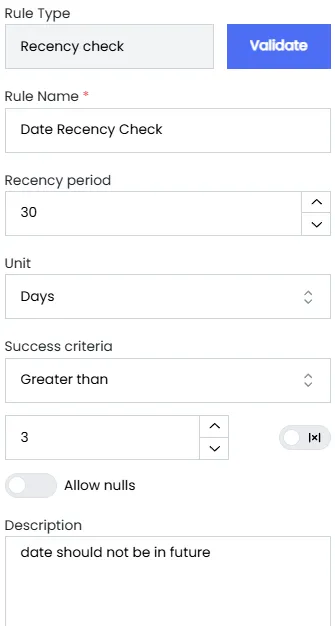Recency Check
Description
The Recency check rule typically refers to a process or action of verifying the timeliness or current relevance of information, actions, or updates.
Rule Configuration
The success of Rule Configurations is based on its ability to define a relevant time frame during which data remains significant. It relies on establishing specific conditions (unit) for evaluating metrics over that period. By setting time parameters such as days, weeks, months, or years, it ensures that only the most recent and pertinent information is considered.
-
Recency period The recency period refers to a specific time frame during which information, actions, or events are considered relevant, valid, or significant.
-
Unit Unit establishes the condition that must be satisfied for a given metric, count, or time frame, in relation to the recency period.
DaysWeeksMonthsYears
Success Criteria
The success criteria are evaluated based on whether the data falls within the specified recency period and meets the conditions defined by the unit
-
The success condition depends on how the
recency periodandunitare configured. -
The success condition is met if this count satisfies the given
operatorandvalue. -
For example, if the
Recency checkis set to30 days, only data or actions that occurred within the past 30 days are considered valid for evaluation.Configuration Fields
-
Operator Options
Greater thanLess thanEqual toBetween(requires specifying a start and end range)
-
Operator Defines the comparison operation (Greater Than, Less Than, Equal To, or Between).
-
Value The threshold value used for success criteria. Required for
Greater than,Less than, andEqual tooperators. -
Value Range Required only when the
Betweenoperator is selected, specifying thestartandendrange. -
Threshold Type Indicates whether the
ValueorValue Rangeto be considered as percentage or an absolute count. -
Allow Null Values Determines if null values are permitted.
-
Sample Input
| ID | Date | Due Date |
|---|---|---|
| 1 | 2025-02-06 | 2025-02-08 |
| 2 | 2024-10-09 | 2024-12-08 |
| 3 | 2024-11-14 | 2025-01-10 |
| 4 | 2024-09-03 | 2024-12-15 |
| 5 | 2025-01-23 | 2025-01-29 |
| 6 | 2025-01-01 | 2025-01-25 |
| 7 | 2024-01-10 | 2024-01-30 |
Sample Rule Configuration
- Recency Period 30
- Unit Days
Sample Success Criteria Configuration
- Operator Greater than
- Value 3
- Threshold Type Absolute Count
- Allow Null Values False

Sample Output
| Column Name | Rule Name | Success Count | Failure Count | Within Threshold | Null Count |
|---|---|---|---|---|---|
| Date | Ship Date Recency | 2 | 5 | No | 0 |
| Due Date | Ship Date Recency | 4 | 3 | Yes | 0 |